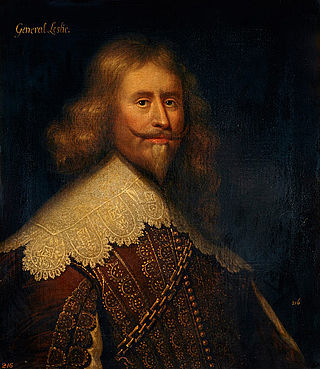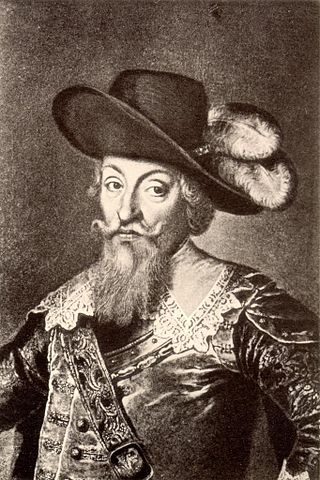
Axel Gustafsson Oxenstierna was a Swedish statesman and Count of Södermöre. He became a member of the Swedish Privy Council in 1609 and served as Lord High Chancellor of Sweden from 1612 until his death. He was a confidant of King Gustavus Adolphus and then Queen Christina, for whom he was at first regent.

The Battle of Wittstock took place during the Thirty Years' War (1618–1648). It was fought on 24 September or 4 October 1636. A Swedish-allied army commanded jointly by Johan Banér and Alexander Leslie decisively defeated a combined Imperial-Saxon army, led by Count Melchior von Hatzfeld and the Saxon Elector John George I.

Baron Gabriel Gustafsson Oxenstierna was a Swedish statesman.

Alexander Leslie, 1st Earl of Leven was a Scottish military officer and peer. Born illegitimate and raised as a foster child, he subsequently advanced to the rank of field marshal in Swedish Army, and in Scotland became Lord General in command of the Army of the Covenanters, a privy councillor, captain of Edinburgh Castle, Lord Balgonie and Earl of Leven. In England he commanded the Army of the Solemn League and Covenant and was senior commander of the Army of Both Kingdoms (1642–1647). Leslie served in the Thirty Years' War, the Bishops' Wars, and most of the English Civil War, fighting primarily in the First English Civil War. Leslie would live a long life, dying roughly at the age of 80 or 81.

Ebba Magnusdotter Brahe was a Swedish countess, landowner, and courtier. She is foremost known for being the love object of King Gustavus Adolphus of Sweden, and because he wished to marry her prior to his marriage, plans which were however never realized. Their love affair has been famous in the Swedish romantic history and the subject of fiction, and are documented in their preserved correspondence.

Ottavio Piccolomini, 1st Duke of Amalfi was an Italian nobleman whose military career included service as a Spanish general and then as a field marshal of the Holy Roman Empire.

Torsten Stålhandske was a Swedish officer in the Swedish army during the Thirty Years' War. He was the son of Torsten Svensson (Stålhandske), a noble military officer of Swedish ancestry from West Gothland, and Carin Lydiksdotter Jägerhorn, of Finnish nobility from southern Finland. Torsten's father died in the Battle of Stångå when he was four years old, and his mother married a Scottish soldier, Major Robert Guthrie.

Johann or Hans Georg von Arnim-Boitzenburg was a German Field Marshal. At different times during the Thirty Years' War, he was a Field Marshal for the Holy Roman Empire and its opponent the Electorate of Saxony. He also pursued various diplomatic tasks.

Robert Douglas, Count of Skenninge, Baron of Skalby, was a Scottish cavalry general during the Thirty Years' War rising to the rank of Field Marshal (1657–1662) in the Swedish-Polish wars that followed. He founded the Swedish branch of Clan Douglas.
The Battle of Chemnitz took place near the town of Chemnitz, in Electorate of Saxony, during the Thirty Years' War. Swedish forces under Johan Banér inflicted a crushing defeat on Rodolfo Giovanni Marazzino who commanded the Saxons and an Imperial detachment under Johann Christoph von Puchheim who was captured by the Swedes.
The Battle of Vlotho was fought on 17 October 1638. It was a victory for the Imperial Army under the command of Field Marshal Melchior von Hatzfeldt, and ended the attempt by Charles I Louis, Elector Palatine, to recapture the Electoral Palatinate.
Elisabet Juliana Banér, was a German noble, married to the Swedish Field Marshal Johan Banér in 1636. She is considered to have wielded a certain influence upon Banér and the Swedish army during the Thirty Years' War.

1636: The Saxon Uprising is an alternate history novel by Eric Flint in the 1632 series, first published in hardcover by Baen Books on March 29, 2011, with a paperback edition following from the same publisher in March 2012. It is a direct continuation of 1635: The Eastern Front. The threads mentioned in this novel are taken up in 1637: The Polish Maelstrom.

Johannes Matthiae Gothus was a Swedish Lutheran Bishop of Strängnäs and a professor of Uppsala University, the rector of the Collegium illustrious, Collegium Illustre in Stockholm (1626–1629) and the most eminent teacher in Sweden during the seventeenth century. He was Bishop of Strängnäs from 1643 to 1664.

Lennart Torstensson, Count of Ortala, Baron of Virestad, was a Swedish Field Marshal and military engineer.

Count Rodolfo Giovanni di Marazzino, also known as Rudolf Morzin, was from an Italian family that lived in Bohemia. From 1629 to 1637 he served in the Imperial Army of the Holy Roman Empire during the Thirty Years War. After the Battle of Wittstock where he still fought for the Emperor in an allied army he was hired by his ally Electorate of Saxony and promoted to the rank of Field Marshal. In 1639 he was defeated at his first battle in charge in the Battle of Chemnitz and dismissed.
Johan Widekindi was a Swedish historian and academic.

Per Gustafsson Banér, also known as Peder Gustafsson Banér was a Swedish nobleman and member of the Privy Council of Sweden.

Gabriel Bengtsson Oxenstierna af Korsholm och Wasa, 1st Count of Korsholma and Vaasa, Finnish: Gabriel Pentinpoika Oxenstierna, was a Swedish statesman, jurist and diplomat.
















